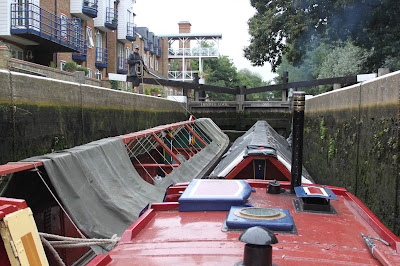Having sorted the photographs out, I moved on to cataloguing the rest of my accumulated
Chertsey paraphernalia; a long overdue task.
I now have two lever arch files, each with its contents safely stored and ordered in plastic wallets - one is of
Chertsey's history prior to my ownership, including copies (and originals where I have them) of all the photos, along with records of maintenance, work done and major purchases; the second is a record of trips made and events attended, including copies of the log and souvenirs like rally programmes and licences. I was quite surprised to be reminded of just how much boating we did in some previous years, especially as
Chertsey was nowhere near as commodious then as she has since become.
Additionally, I still worry about Google not paying their electricity bill - or, it occurred to me suddenly the other morning, taking it into their little corporate heads to start charging for their services - so I investigated the possibilities of turning the blog into PDFs that I could keep and even print. I found
BlogBooker which seems to do the job very well, and
this helpful guide to using it. With the free version you can only do four years worth of blog every six months, but I'll take the chance on Google lasting that long. I've now got PDFs of 2010, 2011, 2012 and 2013. In the spring I'll do the rest. I would like to get round to printing them, but 2010 (albeit that was the year I blogged nearly every day) amounts to over 400 pages. I wonder how many words I've written over the years; a few books' worth, I've no doubt.
One thing I did notice in the process is that some of the photos on the blog have disappeared, and I suspect that these are the ones uploaded using Blogpress while it still worked. I can only guess that these were hosted somewhere different from the ones uploaded directly to Blogger, and that this has since ceased to exist or the links have been broken. It's frustrating, but thankfully only applies to a small minority of the photos.
Talking of books, at Alvecote I had another excellent and keenly priced selection from the Chesterfield Canal Society stall: David Bolton,
Race Against Time; Vivian Bird,
By Lock and Pound; Roger Squires,
Canals Revived, David Owen,
Water Rallies, and P.A.L. Vine's volumes on the waterwats of East and West Sussex, which Jim has taken back to East Sussex to peruse.
I have finished
Race Against Time, which is a very readable account of the establishment and campaigns of the IWA - and its internal politics, horribly familiar to anyone who's been involved with a voluntary and/or campaigning organisation.
After that I was moved to re-read David Blagrove's
Bread Upon The Waters for the third or fourth time. It really is very good; easily as eloquent and elegaic as Rolt, with a more likeable author, and also with funny bits, which Rolt certainly does not offer.






























